
Mathematical card tricks
Effect: While you shuffle the deck repeatedly, the first victim is asked to name their favorite suit. The deck is then given to the second victim, who is invited to riffle shuffle it twice. Meanwhile, a whole number (strictly) between 1 and 7 is requested of a third victim (a die could be rolled if you wish). You write down a prediction, and hand it to the first victim. Taking the deck back, you announce that you will fan through the cards face-up and take out the first six single digit card values encountered in the suit named by the first victim. This you do quite openly, and write down the number formed by those digits. The third victim multiplies this number by the number between 1 and 7 which they named, and it is seen to match the number on your prediction slip.
Method & Mathematics: The whole trick is based on the following cyclical property of the integer 142857 (which is the repeating cycle part of the decimal representation of 1/7. Mnemonic: ``Unfortunate 57''!): if you multiply 142857 by any of the numbers from 1 to 6, you get the same six digits back, permuted cyclically. E.g., 142857 times 3 is 428571, and 142857 times 5 is 714285. Note that the last digit is obvious in each case, and so the cyclic property allows one to predict the entire answer quickly with minimal effort.
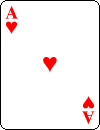
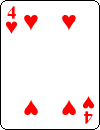
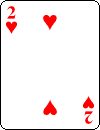
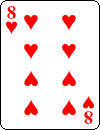
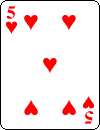

The deck is set up in advance: for each suit prepare a packet of face-up cards consisting of the Ace, 4, 2, 8, 5 and 7 in that order, followed by the 3, 6 and 9 in any order. Turn these four packets face-down, and stack them together in some order you can remember, perhaps the CHaSeD (Clubs, Hearts, Spades, Diamonds) order. Place the remaining 52-36 = 16 cards on top. As you do overhand shuffles, keep an eye on the bottom card, and as soon as the first victim names their favorite suit, stop shuffling when you can tell that the packet of prearranged cards of that suit is near the bottom of the deck.
The two riffle shuffles will move the six key cards upwards in the deck, preserving their order. While the second victim is shuffling, the third names their favorite number, which you multiply by 7. As explained above, this allows you to immediately write down the prediction number without hesitation. When you now fan through the deck, faces up, you are guaranteed to pull out the Ace, 4, 2, 8, 5 and 7 in that order, and the rest is automatic.
Source: Martin Gardner's Mathematical Circus (Knopf, 1979, reprinted by MAA, 1992) provided the idea of the two riffle shuffles distributing one prearranged packet of nine cards, which is a big improvement on the usual versions of this old prediction trick; we extended this to the use of four prearranged packets. Gordon Bean remarks ``Charles Jordan was the first--in the teens--to write about the weaknesses of riffle shuffles in quickly destroying card sequences.'' See Jordan's self-published Thirty Card Mysteries (1919, reprinted in the 1970s).
Bonus points: Gardner appears to make the entire prediction at the outset of the trick, using an ingenious envelope cutting idea of Samuel Schwartz. He also discusses similar tricks that can be performed for savvy audiences who have already encountered the special properties of 142857.